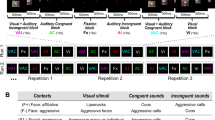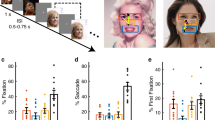Pulling a face to emphasize a spoken point is not seen as just a human prerogative.
Abstract
The perception of human speech can be enhanced by a combination of auditory and visual signals1,2. Animals sometimes accompany their vocalizations with distinctive body postures and facial expressions3, although it is not known whether their interpretation of these signals is unified. Here we use a paradigm in which 'preferential looking' is monitored to show that rhesus monkeys (Macaca mulatta), a species that communicates by means of elaborate facial and vocal expression4,5,6,7, are able to recognize the correspondence between the auditory and visual components of their calls. This crossmodal identification of vocal signals by a primate might represent an evolutionary precursor to humans' ability to match spoken words with facial articulation.
This is a preview of subscription content, access via your institution
Access options
Subscribe to this journal
Receive 51 print issues and online access
$199.00 per year
only $3.90 per issue
Buy this article
- Purchase on Springer Link
- Instant access to full article PDF
Prices may be subject to local taxes which are calculated during checkout

Similar content being viewed by others
References
Sumby, W. H. & Polack, I. J. Acoust. Soc. Am. 26, 212–215 (1954).
McGurk, H. & MacDonald, J. W. Nature 264, 746–748 (1976).
Darwin, C. The Expression of Emotion in Animals and Man 2nd edn (Appleton, New York, 1872/1897).
Hinde, R. A. & Rowell, T. E. Proc. Zool. Soc. Lond. 138, 1–21 (1962).
Rowell, T. E. & Hinde, R. A. Proc. Zool. Soc. Lond. 138, 279–294 (1962).
Hauser, M. D., Evans, C. S. & Marler, P. Anim. Behav. 45, 423–433 (1993).
Partan, S. R. Behaviour 139, 993–1027 (2002).
Kuhl, P. K. & Meltzoff, A. N. Science 218, 1138–1141 (1982).
Patterson, M. L. & Werker, J. F. Inf. Behav. Dev. 22, 237–247 (1999).
Geschwind, N. Brain 88, 237–294 (1965).
Liberman, A. M. & Mattingly, I. G. Cognition 21, 1–36 (1985).
Author information
Authors and Affiliations
Corresponding author
Ethics declarations
Competing interests
The authors declare no competing financial interests.
Rights and permissions
About this article
Cite this article
Ghazanfar, A., Logothetis, N. Facial expressions linked to monkey calls. Nature 423, 937–938 (2003). https://doi.org/10.1038/423937a
Issue Date:
DOI: https://doi.org/10.1038/423937a
This article is cited by
-
Who is there? Captive western gorillas distinguish human voices based on familiarity and nature of previous interactions
Animal Cognition (2022)
-
Breaking conversational rules matters to captive gorillas: A playback experiment
Scientific Reports (2020)
-
How primates acquire their gestures: evaluating current theories and evidence
Animal Cognition (2019)
-
Evolution of facial color pattern complexity in lemurs
Scientific Reports (2017)
-
Functions of an unreported “rocking-embrace” gesture between female Japanese Macaques (Macaca fuscata) in Kinkazan Island, Japan
Primates (2014)
Comments
By submitting a comment you agree to abide by our Terms and Community Guidelines. If you find something abusive or that does not comply with our terms or guidelines please flag it as inappropriate.



